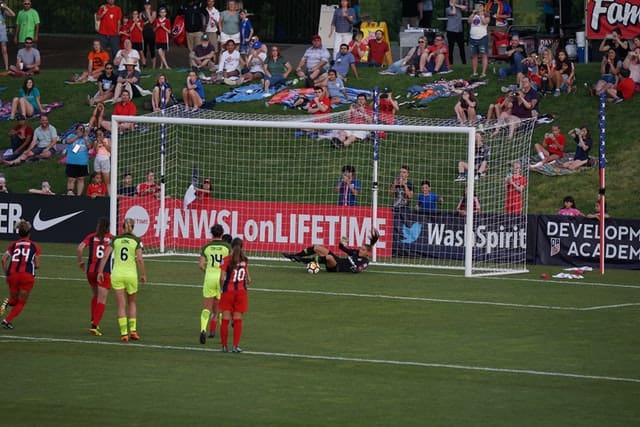If you have been watching soccer for a while, then you have most probably seen at least a few weird scoring methods that made you question whether they are even legal in the first place. One of these scoring methods is passing a penalty kick for someone else.
Is passing the penalty kick to another player allowed in soccer?
Short answer: Yes, it is allowed.
A penalty kick taker can pass a penalty kick as long as they kick the ball forward, don’t touch the ball twice before anyone else touches it, and as long as all other players remain outside the penalty area while the kick is being performed. But how often does a penalty pass happen?
How common is passing a penalty kick in soccer?
For this question, I am going to answer from my own experience instead of bringing in some statistics.
I have been watching soccer for more than 10 years. I have probably watched hundreds if not thousands of soccer matches over the past 10 years, and I have seen a penalty kick being passed only once in the big soccer leagues.
Note that I surely did not watch every single soccer match in the past 10 years, but I believe that I can easily say that although passing a penalty kick is allowed, it is extremely rare
This isn’t very surprising as most of you can already tell.
Why would you pass the ball if you are a few yards/meters away from your opponent’s net and there are literally no other players between you and your opponent’s goalkeeper?
But if you want me to bring the stats, then here they are. According to this analysis on penalty kicks taken in a number consecutive premier leagues, 79.5% of the penalties taken during the observed premier league seasons have converted into goals.
I believe that most professional soccer players will prefer having a 79.5% chance of scoring a goal over risking the opportunity and passing the ball to some other teammate.
But even with all this, some of the biggest soccer players in the game’s history have decided to pass a penalty kick to one of their teammates. Why?
Why would a soccer player pass a penalty kick?
Some of the players who have decided to pass a penalty kick are considered one of the best soccer players in their generation. An example of these players can be both Lionel Messi and Johan Cruyff.
But why would they waste their chance of scoring a penalty kick? Well, it is most likely to put on a show and get an awesome crowd reaction.
When a team is winning, their players won’t be as stressed as when they are not doing well. As you can easily tell, players will try to do some unexpected moves from time to time just to impress the audience and to gain some media publicity after the match.
So in simple words, soccer players may sometimes decide to pass a penalty kick instead of attempting to score just because the goal will be much more entertaining to the audience if the plan goes well.
But does it ALWAYS go well? No it doesn’t. There are a handful of players that have embarrassed themselves by trying to pass a penalty kick and their attempts failed miserably.
Unintentional Penalty Passes
It’s true that intentional penalty passes are rare. However, sometimes the penalty taker passes the ball to their teammate “By mistake” when taking a penalty kick, and these scenarios are common.
Let me explain.
In soccer, if you kick the ball towards the net, and the ball hits the post and bounces back to one of your teammates, then the kick is considered a normal pass to your teammate.
You can see where we are going with this now. A lot of soccer players have “passed a penalty kick” unintentionally by hitting the post instead of succeeding to score a goal.
Summary
Passing a penalty kick in soccer is allowed if the following 3 conditions are met:
- The penalty kick taker kicks the ball forward
- The penalty kick taker doesn’t touch the ball after the kick if no other player have touched the ball yet
- All players other than the goalkeeper and the penalty kick taker are outside the penalty area until the penalty kick is taken.
One interesting thing to note when it comes to the 3rd point is that the players also need to be outside the D area (The penalty arc) during a penalty kick. You can learn more about the D area from this article.

